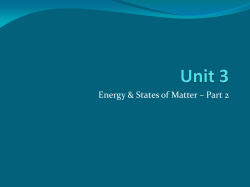
conversion practice - Head
MORE CONVERSION PRACTICE name_____________ date____ Use Dimensional analysis. Show ALL your work. Every number needs a unit! 1. The density of ice is 0.93 g/mL. You have an ice block which has a volume of 300mL. (a) What mass of ice is this? 3 (b) What volume will it occupy as water? (Density of water is 1g/cm ) 3 (c) write a ratio for the conversion of mL and cm . 3 2. The density of osmium is 22.59g/cm . Osmiroid pen nibs, contained osmium because it is a very hard metal and wears well. Osmium was found to be very toxic, so –3 no longer used in nibs! Each nib contained 4.3 x 10 g. (a) What volume of Osmium is this? (b) Osmium costs about $13000/Kg. What is the cost of the osmium in the pen nib? 3. Demo: Draw diagrams of the two beakers on the trolley and label CALORIMETRY problems: substance Cu Ag Au Pb water Fe specific heat J/g°C 0.386 0.235 0.126 0.128 4.18 0.450 1. How much energy is lost when 68.9g of solid gold cools from 455°C to 35°C? 2. What is the mass of a piece of silver if absorbing 97,000J of energy causes a 46.5°C temperature change? 3. What is the specific heat of an unknown substance if 386.6g of it absorb 4500J and have a temperature change of 6.8°C? 4. What mass of water will have a temperature change from 25°C to 100°C if one had 570 Kcal? (the amount of energy in a large order of McDonald’s French Fries.) Answer the rest on binder paper along with the dimensional analysis problems: 5. You have 340 g of each of these metals at room temperature (22°C) A. gold B. copper C. iron a. How many joules are required to raise each sample’s temperature to 100°C. b. Which sample requires the most energy to heat to 100°C? c. Which sample has the lowest specific heat? d. If you allowed the heated samples to cool back down to room temperature (22°C), how many joules would each sample release. Show reasoning. e. If you drop each heated sample into 200 g of room temperature water, which sample will heat the water the most? Show reasoning. Going further: 1. Suppose a 47.6 g piece of metal with a temperature of 100°C is dropped into 100.0 g of water at 24°C. The final temperature of the system is 32.5°C. What is the specific heat of the metal? 2. A blacksmith heated an iron bar to 1445°C. The blacksmith then tempered the metal by dropping it into 42.8 liters of water that had a temperature of 22°C. The final temperature of the water was 45°C. What is the mass of the iron bar?
© Copyright 2025










